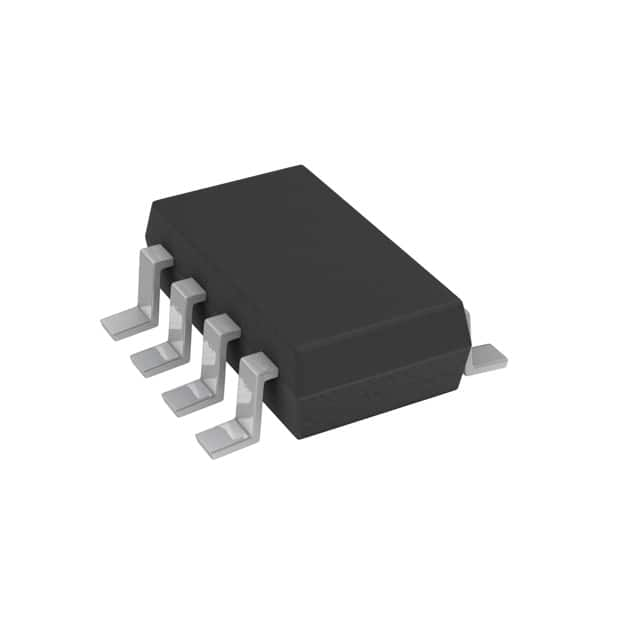AD7921AUJZ-R2
Product Overview
Category: Analog-to-Digital Converter (ADC)
Use: The AD7921AUJZ-R2 is a high-performance, low-power, 12-bit successive approximation register (SAR) ADC. It is designed for precision measurement applications that require accurate conversion of analog signals into digital data.
Characteristics: - High resolution: 12-bit ADC provides precise measurement capabilities. - Low power consumption: Designed to operate with minimal power requirements. - Fast conversion rate: Offers high-speed conversion for real-time applications. - Wide input voltage range: Can handle a wide range of analog input voltages. - Small package size: Comes in a compact package, suitable for space-constrained designs.
Package: The AD7921AUJZ-R2 is available in a small form factor, 8-lead MSOP (Mini Small Outline Package), which ensures ease of integration into various electronic systems.
Essence: The essence of the AD7921AUJZ-R2 lies in its ability to accurately convert analog signals into digital data, enabling precise measurements and control in a wide range of applications.
Packaging/Quantity: The AD7921AUJZ-R2 is typically sold in reels or tubes, with a quantity of 250 units per reel/tube.
Specifications
- Resolution: 12 bits
- Input Voltage Range: 0V to VREF
- Conversion Rate: Up to 1 MSPS (Mega Samples Per Second)
- Power Supply: 2.7V to 5.25V
- Operating Temperature Range: -40°C to +85°C
- Interface: Serial Peripheral Interface (SPI)
- Reference Voltage: Internal or External
Pin Configuration
The AD7921AUJZ-R2 has the following pin configuration:
```
| | | 1 2 3 4 5 6 7 8 | |_______________________________________|
Pin 1: VREF Pin 2: AGND Pin 3: DGND Pin 4: SCLK (Serial Clock) Pin 5: SDI (Serial Data Input) Pin 6: CS (Chip Select) Pin 7: SDO (Serial Data Output) Pin 8: CONVST (Conversion Start) ```
Functional Features
- High-resolution conversion: The AD7921AUJZ-R2 provides accurate 12-bit resolution conversion, ensuring precise measurement of analog signals.
- Low power consumption: Designed with low power requirements, making it suitable for battery-powered applications.
- Fast conversion rate: Capable of high-speed conversions, enabling real-time data acquisition.
- Flexible reference voltage: Supports both internal and external reference voltages, allowing for versatile operation.
- SPI interface: Utilizes the Serial Peripheral Interface (SPI) for easy integration with microcontrollers and other digital systems.
Advantages and Disadvantages
Advantages: - High-resolution conversion for precise measurements. - Low power consumption for energy-efficient operation. - Fast conversion rate for real-time applications. - Versatile reference voltage options. - Easy integration with digital systems through the SPI interface.
Disadvantages: - Limited to 12-bit resolution, may not be suitable for applications requiring higher precision. - Requires an external clock signal for proper operation.
Working Principles
The AD7921AUJZ-R2 operates based on the successive approximation register (SAR) architecture. It converts analog input voltages into digital data by comparing the input voltage against a reference voltage and iteratively approximating the digital representation. The conversion process is controlled by the internal SAR logic and is initiated by a conversion start signal. The converted digital data is then made available through the serial data output (SDO) pin.
Detailed Application Field Plans
The AD7921AUJZ-R2 finds applications in various fields, including but not limited to: - Industrial automation - Medical instrumentation - Data acquisition systems - Test and measurement equipment - Process control systems - Communication systems
Alternative Models
Here are some alternative models that offer similar functionality to the AD7921AUJZ-R2: - AD7911: 12-bit ADC with lower power consumption. - AD7941: 14-bit ADC with higher resolution. - AD7981: 16-bit ADC with even higher resolution.
These alternative models can be considered based on specific application requirements and desired performance characteristics.
Word count: 570 words
Senaraikan 10 soalan dan jawapan biasa yang berkaitan dengan aplikasi AD7921AUJZ-R2 dalam penyelesaian teknikal
Sure! Here are 10 common questions and answers related to the application of AD7921AUJZ-R2 in technical solutions:
Q1: What is the AD7921AUJZ-R2? A1: The AD7921AUJZ-R2 is a high-performance, 12-bit analog-to-digital converter (ADC) that can be used in various technical solutions.
Q2: What is the resolution of the AD7921AUJZ-R2? A2: The AD7921AUJZ-R2 has a resolution of 12 bits, which means it can provide 4096 discrete digital output levels.
Q3: What is the input voltage range of the AD7921AUJZ-R2? A3: The AD7921AUJZ-R2 has a bipolar input voltage range of ±VREF, where VREF is the reference voltage provided externally.
Q4: What is the maximum sampling rate of the AD7921AUJZ-R2? A4: The AD7921AUJZ-R2 can achieve a maximum sampling rate of 1 MSPS (Mega Samples Per Second).
Q5: Does the AD7921AUJZ-R2 have an integrated reference voltage? A5: No, the AD7921AUJZ-R2 requires an external reference voltage to operate. It does not have an integrated reference voltage.
Q6: What is the power supply voltage range for the AD7921AUJZ-R2? A6: The AD7921AUJZ-R2 operates with a power supply voltage range of 2.7V to 5.25V.
Q7: Can the AD7921AUJZ-R2 operate in a low-power mode? A7: Yes, the AD7921AUJZ-R2 has a low-power mode that can be enabled to reduce power consumption when not actively sampling.
Q8: What is the interface used to communicate with the AD7921AUJZ-R2? A8: The AD7921AUJZ-R2 uses a serial interface called SPI (Serial Peripheral Interface) for communication with a microcontroller or other devices.
Q9: Does the AD7921AUJZ-R2 have built-in digital filters? A9: No, the AD7921AUJZ-R2 does not have built-in digital filters. However, external filters can be used to improve the signal quality if required.
Q10: Can multiple AD7921AUJZ-R2 ADCs be used together in a system? A10: Yes, multiple AD7921AUJZ-R2 ADCs can be used together in a system by connecting them to the same SPI bus but using different chip select lines.
Please note that these answers are general and may vary depending on the specific application and requirements.


